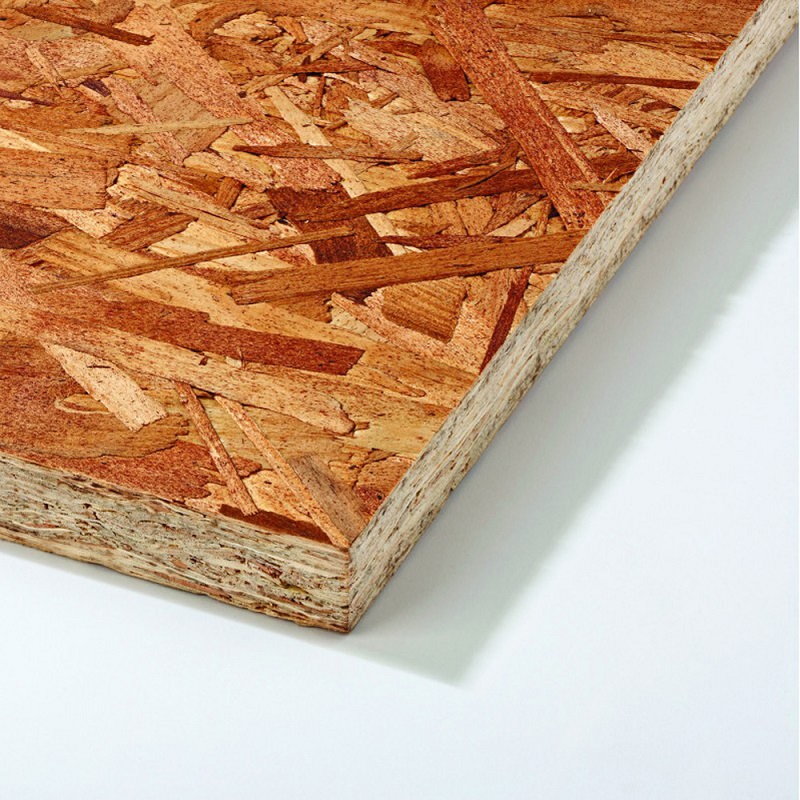Oriented strand board
Oriented strand board (OSB), also known as flakeboard or sterling board, is a type of engineered sheet timber product that is typically used as sheathing in wall panels, flooring and roof decking. OSB has similar properties to plywood, another engineered sheet timber product, and is suitable for load-bearing applications. It is less commonly used for exterior applications.
It was first developed in America in the early-1960s, and is made of layers of compressed timber strands bonded with adhesive. The individual strands – or flakes – are usually about 2.5 x 15 cm, and lie unevenly across each other, resulting in OSB’s rough and variegated surface.
OSB is typically manufactured to a ratio of 95% timber strands to 5% wax and synthetic resin adhesives (typically, moisture-resistant binders such as phenol formaldehyde (PF), urea formaldehyde (UF), isocyanate (PMDI) or a combination).
Timber strands are sifted and lain into a mat located on a forming line before being coated with the resin. The required thickness of the panel determines the number of layers that are placed. A thermal press is used to compress the mat which bonds the strands by heat activation and curing of the resin. The mat is then cut into individual sizes as required.
Impermeability to water can be achieved through the use of additional membranes.
OSB can be more cost-effective than plywood. In terms of strength, unlike natural timber there is not a continuous grain, however, it does have an axis – found with the alignment of the surface strands – along which its strength is greatest.
[edit] Related articles on Designing Buildings
Featured articles and news
Grenfell Tower fire – eight years on
A time to pause and reflect as Dubai tower block fire reported just before anniversary.
Airtightness Topic Guide BSRIA TG 27/2025
Explaining the basics of airtightness, what it is, why it's important, when it's required and how it's carried out.
Construction contract awards hit lowest point of 2025
Plummeting for second consecutive month, intensifying concerns for housing and infrastructure goals.
Understanding Mental Health in the Built Environment 2025
Examining the state of mental health in construction, shedding light on levels of stress, anxiety and depression.
The benefits of engaging with insulation manufacturers
When considering ground floor constructions.
Lighting Industry endorses Blueprint for Electrification
The Lighting Industry Association fully supports the ECA Blueprint as a timely, urgent call to action.
BSRIA Sentinel Clerk of Works Training Case Study
Strengthening expertise to enhance service delivery with integrated cutting-edge industry knowledge.
Impact report from the Supply Chain Sustainability School
Free sustainability skills, training and support delivered to thousands of UK companies to help cut carbon.
The Building Safety Forum at the Installershow 2025
With speakers confirmed for 24 June as part of Building Safety Week.
The UK’s largest air pollution campaign.
Future Homes Standard, now includes solar, but what else?
Will the new standard, due to in the Autumn, go far enough in terms of performance ?
BSRIA Briefing: Cleaner Air, Better tomorrow
A look back at issues relating to inside and outside air quality, discussed during the BSRIA briefing in 2023.
Restoring Abbotsford's hothouse
Bringing the writer Walter Scott's garden to life.
Reflections on the spending review with CIAT.
Retired firefighter cycles world to raise Grenfell funds
Leaving on 14 June 2025 Stephen will raise money for youth and schools through the Grenfell Foundation.
Key points for construction at a glance with industry reactions.
Functionality, visibility and sustainability
The simpler approach to specification.























